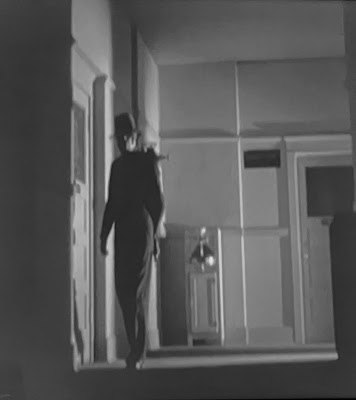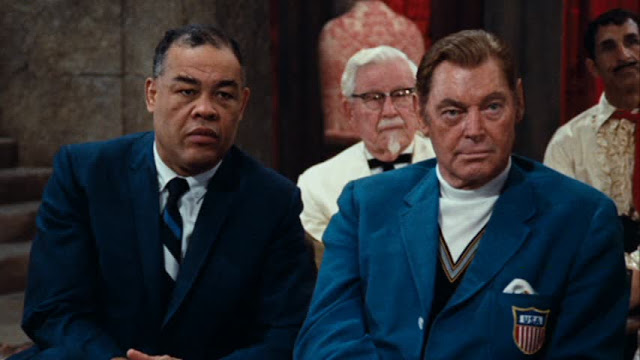I recently picked up and flipped through my copy of William K. Everson's classic A Pictorial History of the Western Film, as one does when escaping the heat of an Alabama summer day. What did I find but a couple of stills and some discussion of Johnny Mack Brown's role as William Bonney in the 1930 film Billy the Kid. Let's investigate.
Thursday, September 21, 2023
Johnny Mack Brown as Billy the Kid
Friday, September 15, 2023
Gail Patrick in "The Preview Murder Mystery"
One of the topics I bring out from time to time on this blog is film actresses from the state whose careers began before 1960. I've covered some others after that date, too, but today's post fits that group.
One of those pre-1960 actresses is Birmingham native Gail Patrick. A career overview I posted in 2015 is here. In 2019 I wrote about her role as a private detective [really!] in Murder at the Vanities, a truly bonkers 1934 pre-code film. In 2020 I posted about her post-acting career as Executive Producer on the classic Perry Mason TV series and her appearance in the final episode. In 2021 I wrote about her role as the femme fatale in The Maltese Falcon--a radio version, but still....
Now we come to her role in The Preview Murder Mystery from 1936. I watched this one recently on TCM and really enjoyed it. There's a rather interesting framing device--it's a movie about the making of a movie and features quick action, witty dialog and some murders. Director Robert Florey would helm over 50 movies and numerous episodes of TV shows in his long career. By the time he made this one, he had already directed such classics as the Marx Brothers first feature, The Cocoanuts [1929] and Murders in the Rue Morgue [1932].
The film being filmed is "Song of the Toreador", and we get to see some extensive scenes in its preview screening. We also see even longer scenes involving the filming process, so that the cast and crew of "Toreador" are much of the cast and crew of Preview. Very meta. "Song" is a remake of a silent film starring the late husband of Patrick's character, Claire Woodward Smith.
A lot of this film's snap, crackle and pop is courtesy of the performances by and dialog written for Reginald Denny and Frances Drake as they play the studio publicity head and his secretary. A running gag is Denny's constant proposals of marriage, and refusals by Drake, whose character is an astrology nut and keeps telling him the stars are not aligned properly.
Catch this movie if you have a chance. It's only an hour long and is available on YouTube.
Some more comments are below.
Friday, August 4, 2023
Joe Louis in "The Phynx"
I can guess what you're thinking--what's a phynx? Let's investigate.
"The Phynx" is a film released briefly in May 1970 by Warner Brothers Studios. Warner finally released it on DVD in 2012, and I watched it recently on Turner Classic Movies. The movie is certainly not a classic, but it has some amusing moments.
A plot summary is hilarious enough. Communists in Albania have kidnapped a number of celebrities from American entertainment and sports worlds. I don't even remember why. In order to free the hostages, U.S. intelligence puts together a rock band from scratch and turns them into world superstars. The group's name? The Phynx, of course. Once famous, the group can appear in concert in Albania and rescue the celebrities.
But wait--there's a hitch. There's a secret map that will lead the musicians to the castle where the hostages are being kept. The map is drawn in three parts on the tummies of three beautiful young women residing in different European cities. In order to find the pieces, Phynx members must "examine" hundreds of women. After that exhausting ordeal, they put the map together and head for Albania.
Are you with me so far?
Naturally, all the kidnapped celebrities are found and released. A major feature of this portion of the film is a sequence in which they are all introduced to us, the viewers, before leaving Albania. The list includes Johnny Weissmuller and Maureen O'Sullivan (the most famous movie Tarzan and Jane), Leo Gorcey and Huntz Hall (the Bowery Boys), Ed Sullivan, James Brown, Colonel Sanders, Guy Lombardo, Andy Devine, Ruby Keeler, Edgar Bergen, Butterfly McQueen, Jay Silverheels (Tonto), Rudy Vallee, Xavier Cugat, Trini Lopez, Dick Clark, Richard Pryor, Harold "Oddjob" Sakata, George Jessel, and Rhona Barrett.
Alabama native and former heavyweight boxing champ Joe Louis was also included. As the stars leave the castle in horse-drawn carriages, no less, we see duos or trios of them cracking jokes. Johnny Weissmuller says "Me Tarzan, you Jane" to O'Sullivan, a phrase never uttered during any of their many movies together. Louis and Marilyn Maxwell are sitting together and Louis actually makes an income tax joke, referencing his well-known woes with the IRS over back taxes he owed.
This film is crazy, baby, really far out. But I had fun watching it. The parade of mostly-aging, many-by-1970 forgotten stars is a shout-out to people who had entertained millions across the decades. I remember often watching Leo Gorcey and Huntz Hall as the Bowery Boys when I was a kid, on Saturday mornings, I guess. They weren't as funny as the Three Stooges, but were pretty amusing. I also appreciated the appearance of John Hart as the Lone Ranger. I much preferred him over Clayton Moore, whom he replaced in the 1952-53 season during a contract dispute.
The list goes on. Dorothy Lamour! Martha Raye! Joan Blondell! Ed Sullivan! Ruby Keeler! Rudy Vallee! Clint Walker in a hilarious turn as a master sergeant! Oh, and there's Richard Pryer! Butterfly McQueen! Trini Lopez! Sadly, I'm old enough to know who all these people are/were. Check out the film's IMDB entry for a full cast list.
I should note one other appearance. Actress Sally Struthers made her first film appearance, although uncredited, as the World's Number One Fan of The Phynx.
Louis and Weissmuller looking serious earlier in the film. Who's that mysterious gentleman behind them??
Friday, September 30, 2022
Silent Filmmaking in the Birmingham Area, Part 6: Homegrown Silents (2)
Louise O. Charlton, Director
E.C. Krug, Vice-President
J. Mont Thomas, Secretary
John E. Roberts, Treasurer
Harry Garrett, Chair
Mrs. W.H. Yenni
Howard Parish
Mrs. Erwin Caldwell, Chair
Robert Bromberg
Mrs. J. Martin-Smith, Jr.
David R. Solomon, Chair
Mrs. Priestly Toulman, Jr.
Mrs. Howard Parish
C.L. Engle, Chair
John Roberts
Erwin Caldwell
Trustworthy [1929, 35mm]
The World, the Flesh and Mercedes [1929?]
Man Shy [1929?]
Birmingham News 14 July 1929 via Birmingham Public Library Digital Collections
Thursday, September 2, 2021
Movies with Alabama Connections: Stark Love (1927)
Well, I knew that Fob James, Jr., acted like a monkey while governor, but I didn't realize until recently that his father had actually appeared as the male lead in a silent movie in 1927. Let's investigate.
That film was Stark Love, set in the Great Smokey Mountains where it was filmed near Robbinsville, North Carolina. Directed by Karl Brown and written by him and Walter Woods. the movie was financed by a major Hollywood studio--what is now Paramount Pictures--and intended as a realistic portrait of people in Appalachia.
To that end the two lead characters Rob Warwick and Barbara Allen are played by non-professional actors, Forrest Hood James, Sr., and Helen Mundy. Director Brown wanted to tell a story about mountain people that would be realistic in a way unseen before in Hollywood films. "Hillbilly" movies had been popular but full of stereotypes. The article about Mundy linked previously has some interesting background about casting and filming Stark Love. Numerous comments about the film can be found here.
Brown located his two leads in Knoxville, Tennessee. Mundy was a 16 year-old high school student. Filming was done so far in the backwoods a new road had to be constructed. In the story Rob is the son of a harsh father who mistreats his mother. Rob learns to read and wants a better life for himself and the neighbor's daughter he's attracted to, Barbara [Mundy]. After various hardships and the death of his mother, Rob and Barbara escape their isolated community for a better life. Director Brown portrayed stereotypes of his own in his film; he had no direct knowledge of or experience with Appalachian mountain people.
According to one source, [Ralph Draughon, Jr., Delos Hughes & Ann Pearson, Lost Auburn: A Village Remembered in Period Photographs. New South Books, 2012, p. 143] the premier of Stark Love took place at the first commercial movie theater in Auburn, the original Tiger Theater, which operated from 1926 until 1928. Owned by Foreman Rogers, the business was located on North College Street in an old storefront. The date was September 21-22, 1927; admission was 35 cents for adults and 15 cents. In contrast, the IMDB says the film was released on February 28, 1927, and in those days films took time to make their way around the country due to limited numbers of prints, slower transportation, etc. I'm just not sure about the "premier" discrepancy.
Stark Love was presumed to be one of the many lost silent films until a copy was discovered in a Czech archive in 1968 by film historian Kevin Brownlow. Although still little seen today, it was added to the Library of Congress' National Film Registry in 2009. A blurry copy is available on YouTube.
Neither lead ever appeared in another film. Mundy married, moved to Michigan and died in 1987.
His Word War II draft card [found via Ancestry.com] tells us a bit about Forrest James, Sr. He was born in Waverly, Alabama, on August 10, 1905, and married to Rebecca Ellington James. He was 5'9" tall, weighed 160 and had brown hair and blue eyes. Karl Brown offered to take James to Hollywood, but he followed his mother's wishes and returned to finish college at what is now Auburn University. James and his twin brother William both lettered in three sports at Auburn. James then taught high school and coached baseball before pursuing a business career. He died July 2, 1973, in Birmingham and is buried in Garden Hills Cemetery in Opelika.
By the way, I can highly recommended Brownlow's massive 1968 book The Parade's Gone By as a wonderful history of silent filmmaking.
FURTHER READING
Articles by John White:
"Hollywood Comes to Knox County," Kentucky Humanities, Spring 2010: 29-34. Published by the Kentucky Humanities Council.
"Forrest James, Hollywood's Reluctant Star." Alabama Heritage. Number 93, Summer 2009: 44-53. Published by the University of Alabama, the University of Alabama at Birmingham, and the Alabama Department of Archives and History.
"Myth and Movie Making: Karl Brown and the Making of Stark Love." Film History, an International Film Journal. Volume 19, 1 (2007): 49-57. Published by Indiana University.
This book has a long chapter on the film:
Williamson, Jeremy Wayne. Hillbillyland: What the Movies Did to the Mountains and what the Mountains Did to the Movies. North Carolina: UNC Press Books, 1995.


















































